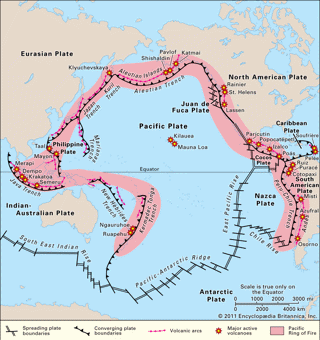What was the Fukushima disaster?
10-years ago in 2011 tragedy struck the eastern coast of Japan as an earthquake magnitude 9.1 hit the north-eastern seaboard at 14:46 local time (05:46 GMT) on 11 March 2011. A giant tsunami quickly swept inland destroying a nuclear power plant in the Tōhoku region of Honshu. The power plant was located on the coast at Okuma as nuclear power plants often utilise seawater for their cooling systems. The Fukushima Daiichi Nuclear Power Plant has since been decommissioned but Japanese authorities are still agonising over what to do with the leftover 1.25 million tonnes of radioactive water used to cool the melted reactors.
A good overview of the disaster is the BBC video Fukushima: The nuclear disaster that shook the world, whilst the Guardian’s Then and Now images highlights the immense destruction of 2011.
The disaster killed more than 18,000 people wiping entire towns, like Okuma (where the Daiichi Nuclear Power Plant is), off the map. The event has become infamous for being:
-
The world’s second-worst civilian nuclear disaster (after the Chernobyl disaster of 1986)
-
A natural event but a human-induced disaster. An independent investigation in Japan apportioned blame to the plant operator and energy company Tokyo Electric Power (Tepco) for failing to meet safety requirements or to plan for such an event
In order to fully appreciate the scale of devastation access this report and the 35 photographs from The Atlantic and this footage of the tsunami from National Geographic.
The cause
Japan lies in an extremely tectonically active region of the world, on the Pacific Ring of Fire (see Figure 2). The earthquake was an enormous 9.1 in magnitude making it the largest earthquake in Japan’s history and the fourth most powerful earthquake since records began.


A recap of the short-term impacts
The short-term refers to the immediate aftermath of an event, in this case in the days and weeks that follow a natural disaster.
-
In the short term 16 people were injured in the initial explosions at the nuclear power plant
-
Over 18,000 people were killed and 465,000 were evacuated
-
There were increased radiation levels as far as Tokyo, 225-kilometres away
-
A 4-metre-high wave was triggered at 15:27 local time which the power planet seawall successfully deflected (as it is built to withstand 10-metre-high waves)
-
However, a second wave was triggered later at 15:35 which was 15-metres in height. This wave overwhelmed the seawall. Crucially, this destroyed the water pumps of the Fukushima Daiichi Nuclear Power Plant, rendering the power plant powerless. You can see footage of the tsunami in this video, as it sweeps into Miyako Harbour from 2 minutes-in
-
5 out of the 6 reactors lost power. Without a cooling mechanism a nuclear meltdown occurs
-
Ultimately, 3 nuclear reactors exploded releasing radiation
-
Reactors 5 and 6 were brought under control with emergency replacement diesel generators
-
Wastewater was contaminated. Seawater that is tested near the Fukushima Daiichi Nuclear Power Plant had 1,250 times the legal limit of iodine 131
10-years on
10-years on the country is still experiencing the aftereffects of such a big disaster. Japanese authorities believe it will take up to 40 years in total to finish the work.
On 11 March 2021 Japan recognised and mourned the 10-year anniversary of the Fukushima disaster. Today nearby roads are closed with 40,000 people still unable to return to their homes near the power plant, due to high levels of radioactive contamination. 2.4% of the land around the site remains a no-go zone in the Fukushima Prefecture. Milk and water show excessively high levels of radioactive iodine to this day.
A public ceremony was held in the Tokyo’s national theatre to mark the anniversary (you can watch a Sky News report on the ceremony titled Fukushima Remembered) with Emperor Naruhito saying that a decade on:
“The unforgettable memory of the tragedy” persists a decade on.
Emperor Hironomiya Naruhito
Japan’s Prime Minister, Yoshihide Suga, added that the challenges faced by survivors had been “compounded” by the pandemic and natural disasters, referencing a recent earthquake in Japan which registered 7.3 in magnitude (13 February 2021).
This recent earthquake, which injured 100 people and left 950,000 households initially without power, is an aftershock of the 2011 earthquake. Described as a decade-long-delayed aftershock it occurred on the main shock fault plane where the original focus occurred. Seismologists believe it has allowed for stress to be released and for readjustment along the faultline.
Since 2011, there has been a huge surge in anti-nuclear demonstrations and public concern over the energy technology. Anti-nuclear activists have grown substantially in the country and as a result this form of energy production has waned. In Japan today, nuclear power now only contributes a little over 7% to the nation’s electricity supply (not the originally planned 22% a decade ago).
Economically the earthquake and tsunami were devasting, a total of $360 billion has been lost from the Japanese economy since 2011.
In the long term there have been limited deaths associated with the disaster. The World Health Organisation released a report in 2013 stating the predicted risks of cancer for the region were low, and that there were “no observable increases in cancer rates above [expected] baseline rates”.
